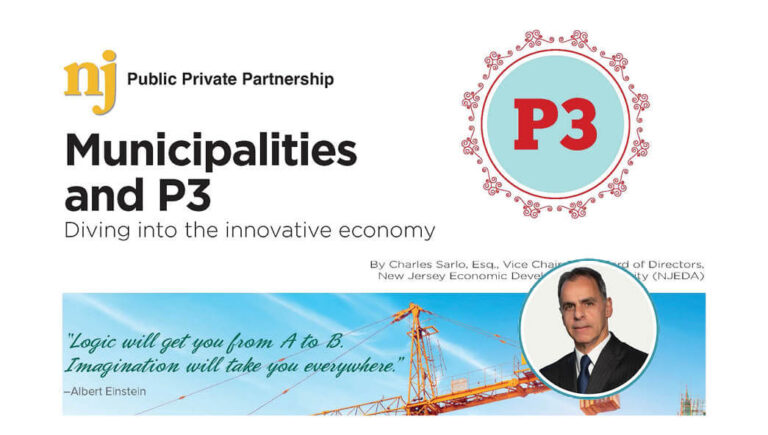Municipalities have the ability to be innovative and creative in addressing their infrastructure capital needs as a result of the newly enacted Public Private Partnership Law (PPP or P3), which became effective February 10 (L.2018, c.90, s.1; N.J.S.A. 40A:11 -52, et seq.). In order to ensure that a municipality’s economic decisions are financially prudent, the P3 law has built-in safeguards in the form of competitive solicitation, transparency in the form of public hearings, and checks and balances in the form of the State Treasurer making specific findings in connection with the approval of PPP projects.
The simplest definition of a Public Private Partnership is a contractual arrangement between a public entity and a private entity that allows for greater private sector participation in the delivery and financing of capital projects with the objective of shifting risk to the private sector. The P3 law allows for a design-build-finance-operate-maintain methodology to deliver capital projects and is an alternative project delivery method to the traditional procurement pursuant to the Local Public Contracts Law (LPCL), which is recognized as a design-bid-build approach.
Broad applicability
The P3’s statutory applicability in New Jersey is broad, as it allows the P3 project delivery model to be used for any building, local or county road, vertical structure, or facility constructed or acquired by a local government unit (defined to not only be municipalities, but also other public entities that are subject to the LPCL or Local Redevelopment and Housing Law) to operate local government functions, including any infrastructure or facility used or to be used by the public or in support of a public purpose or activity.
Today, the private sector’s innovative intellect and financial vigor can craft and implement proposed solutions to a municipality’s infrastructure needs. The theme of private sector innovative intellect is front and center in New Jersey’s P3 law, which allows the private sector to submit an unsolicited proposal in the form of a “project playbook” that includes certain statutory requirements.
Should the municipality elect to proceed, it must seek competitive proposals via a public procurement process that must also meet the minimum statutory requirements that that satisfy the same basic purpose and need of the unsolicited proposal. In the alternative, the municipality can issue a public procurement request-for-qualifications. Upon a determination of the qualified respondents, based, in part, on minimum standards to be promulgated by the State Treasurer, the municipality is required to issue a request for proposals.
Regardless of whether the unsolicited proposal or the solicited proposal pathway is applied, the municipality would rank the proposals received in order of preference based, in part, on minimum standards to be promulgated by the State Treasurer. Thereafter, the municipality is required to make specific determinations of the top-ranked proposals and hold a public hearing at which the specific findings must be made in order to find that the project is in the best interest of the public.
Subsequent to the public hearing, the municipality is required to submit a P3 application to the State Treasurer for review and approval. The statute requires the submission of specific items, including: full description of the proposed P3 agreement, a full description of the project, description of any agreement for the lease of a revenue-producing facility related to the project, the estimated costs and financial documentation for the project showing the underlying financial models and assumptions that determined the estimated costs, timetable for project completion, evidence of the public benefit in advancing the project as a P3, and the municipality’s findings during it’s proposal review and the public hearing.
For municipal projects, the State Treasurer, in consultation with the New Jersey Economic Development Authority (NJEDA) and the Department of Community Affairs (DCA), is statutorily charged with approving P3 applications. In order to validate that the proposed P3 project is in the best interest of the public, the State Treasurer must make specific findings for a P3 project approval.
If the P3 project is approved, the municipality can then enter into a P3 agreement with the private sector, which needs to include certain provisions, such as a completion date guarantee, liquidated damages, maximum rate of return to private entity, and a provision for the distribution of excess earnings to the local government or the private party for debt reduction, a project labor agreement, performance and payment bonds, prevailing wage, and the establishment of a construction account with a third-party financial institution to act as a collateral agent.
As with any newly enacted law, one can certainly anticipate litigation involving the P3 law in which a party seeks to clarify the intent of certain provisions, reconcile inconsistencies or challenge the law’s applicability.
Understandably, the initial inquiry by a public official will invariably be “Why?”
Why chose to undertake a capital infrastructure project on a path that appears to be complex, burdensome, and untested–while it may also be assumed to be more costly and potentially fraught with a litigation challenge–rather than the time-tested procurement under the Local Publics Contract Law. For each initial negative reaction, P3 advocates and P3 case studies can illustrate a positive counter. Generally, it has been proven that there is a role for the private sector to foster solutions for public sector challenges. A well-designed P3 is intended to be performance-based and outcome-focused with a risk-sharing approach where asset performance is optimized for the long term.
Qualifying considerations
Notwithstanding that some who have had firsthand experience undertaking a capital project under the LPCL would certainly express concerns that they experienced regarding project cost overruns, claims, and missed project completion dates, it should be recognized that the P3 law should not be considered a blanket replacement to capital project procurement under the LPCL, as not every project is appropriate for a P3 arrangement.
National P3 players will advise that a project cost of $50 million is the minimum project threshold for a P3 project. The New Jersey P3 law prohibits the bundling of projects (i.e., two or more projects considered as one for a P3 arrangement). However, there are many infrastructure needs of municipalities and other local government units with project costs less than $50 million.
Notwithstanding this industry threshold, it is fully expected and anticipated that the New Jersey local know-how of the private sector will adeptly be able propose P3 arrangements to the public sector pursuant to the P3 law, for many of a municipality’s capital infrastructure projects regardless of project size. The public sector should embrace the imagination of the private sector as related to its capital infrastructure needs and base its procurement decisions on sound economic analysis, which supports beneficial fiscal and social impacts as required by the P3 law.
The dawn of Public-Private-Partnerships in New Jersey is now. As may be applicable, it would certainly be prudent for public officials, who are charged with balancing the needs for public funds while developing, upgrading or replacing public infrastructure, to certainly consider the Public-Private-Partnership business model as an alternative procurement process, notwithstanding its embryonic stage.
This article originally appeared in New Jersey Municipalities.





